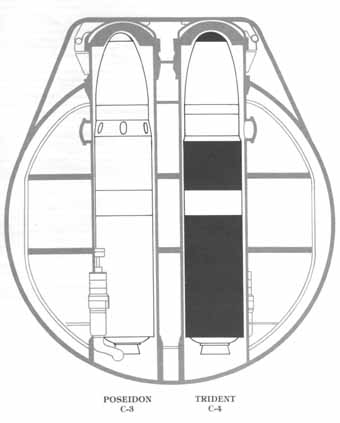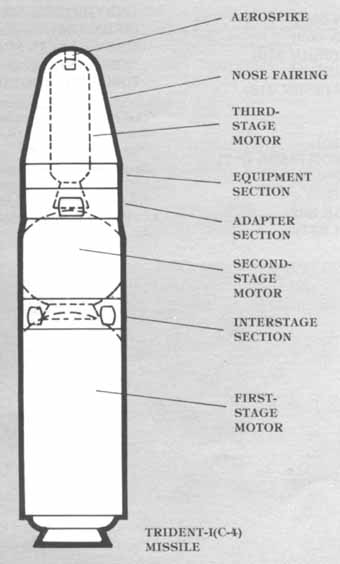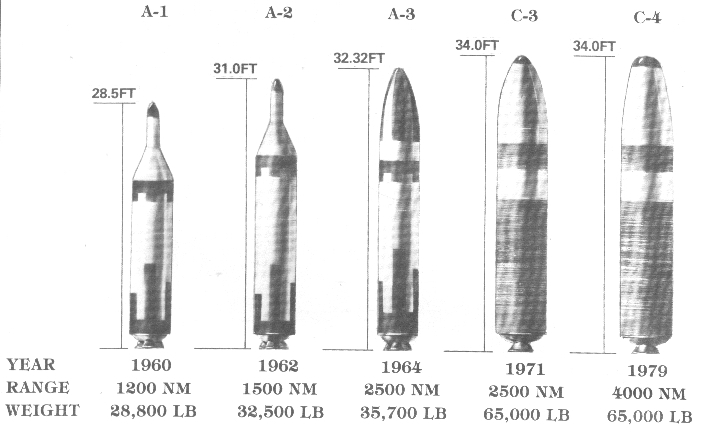|
Most of the information on these pages was
selected from a SSP publication circa 1978. The booklet was
distributed to inform the public about SP and SSP's role in the Fleet
Ballistic Missile Program. The book is in the public domain. Special Projects (SP) Became Strategic Systems Projects (SSP) |
|
DETERRENCE
The Nation's mix of strategic deterrent weapons has a
purpose unique in the history of warfare: To prevent nuclear war.
The Fleet Ballistic Missile FBM Weapon System is the
Navy's major contribution to this mix. Hidden, mobile, ready, a fleet of
nuclear powered submarines, each carrying 16 nuclear tipped POLARIS or
POSEIDON missiles, ranges the oceans of the world, assuring a potential
enemy that, should he launch a nuclear attack on the United States, he
would receive a devastating nuclear blow in response. He is thus deterred
from initiating a nuclear exchange.
 THE SYSTEM THE SYSTEM
The United States Navy's Fleet Ballistic Missile Weapon
System, better known by the name of its missile, POLARIS, has been
operational since 15 November 1960. On that date, the first FBM submarine,
USS GEORGE WASHINGTON (SSBN 598) deployed on patrol with a full load of 16
tactical missiles.
In addition to missiles and submarines, the FBM system
covers the entire aspect of activities from research,
(Up and right) |
development, building of hardware, training of crews,
and construction of facilities, through the continued operational support
of the deployed weapons systems. Operational FBM submarines in the
Atlantic are under control of the Commander in Chief, U.S. Atlantic
Command, who exercises his authority through the Commander in Chief, U.S.
Atlantic Fleet, and Commander Submarine Force, U. S. Atlantic Fleet. FBM
submarines in the Pacific are under the control of the Commander in Chief,
U.S. Pacific Command, who exercises his authority through the Commander in
Chief, U.S. Pacific Fleet, and Commander Submarine Force, U.S. Pacific
Fleet.
Selection of targets and their assignment to
operational FBM submarines are under the control of the Joint Chiefs of
Staff.
System development and production are managed for the
Navy by the Director of Strategic Systems Projects, Rear Admiral Robert
II. Wertheim. Assisting him is an imposing team of Navy missile experts,
scientific leaders, universites and more than 20,000 industrial
contractors and government agency personnel.
STATUS OF SYSTEM
All 41 ships of the authorized FBM submarine force have been on
operational patrol. The 41st, USS WILL ROGERS (SSBN 659) was commissioned
on 1 April 1967 and deployed on patrol on 3 October 1967. The first 10
submarines (598 and 608 Class) carry the POLARIS missile on operational
patrol. Subsequently, the other 31 POLARIS SSBNs have been returned to the
United States, and refitted to carry the longer range POSEIDON C-3
missile, which has been deployed in FBM submarines since March 1971. All
31 of the Navy's 41 FBM submarines scheduled to be converted to carry the
POSEIDON C-3 have been completed.
Thirty-one FBM submarines are assigned to the Atlantic Fleet and 10 to
the Pacific Fleet.
(Down and left) |
|
THE BRITISH POLARIS PROJECT The joint United
States/United Kingdom program established by the Polaris Sales Agreement
was a direct result of the now historic meeting at Nassau in December 1962
between President Kennedy and Prime Minister MacMillan. Strategic Systems
Project Office (SSPO) has additional responsibilities related to the
British Polaris Force.
Under the terms of the Sales Agreement, the U.S. has sold Polaris
missiles (less warhead) to the U.K. In addition to the missiles, the
subsystems which make up the weapon system were also sold. The British
have built their own nuclear powered submarines to house the weapon
system, and provided their own warheads. The U.K. deterrent force consists
of 4 Polaris submarines, each carrying 16 nuclear Polaris A-3 missiles.
The Director, Strategic Systems Projects, is the U.S. project officer
for this program. Rear Admiral Sir David Scott, KBE, CB, the Chief Polaris
Executive (Royal Navy), is the British project officer. A small British
staff is assigned to SSPO and a US liaison from SSPO has been assigned to
duty in the British Ministry of Defence to assure prompt and effective
support to the U.K. Polaris program. A joint Steering Task Group, chaired
by the Admirals in turn, meets alternately in London and Washington three
times a year.
December 13, 1969 marked the end of the initial outfitting period. At
that time the U.K. had their operating base at
(Up and right) |
Faslane built and all four Polaris submarines accepted for
service. These British designed submarines were built in the North of
England, two at the Barrow Shipyard of Vickers shipbuilding Group and two
at Cammell Lairds of Birkenhead. The first U.K. submarine, HMS RESOLUTION,
was launched in September 1966 and visited Cape Canaveral in February and
early March 1968, where both Port and Starboard Crews successfully
launched a Polaris A-3 missile into a downrange target area. RESOLUTION
made her first deterrent patrol in June 1968. HMS RENOWN was launched in
February 1967. HMS REPULSE was launched in November 1967, and HMS REVENGE
in March 1968. After routine overhauls, each returns to fire missiles on
the U.S. Eastern Test Range. Similar in size to the USS LAFAYETTE, the
British submarines have the distinctive whale-like hull form the British
have already adopted for their first generation nuclear hunter/killer
submarines, with the diving planes positioned on either side of the bow
and not on either side of the sail as the U.S. FBM submarines. The
submarines are powered by British pressurized-water nuclear reactors built
by Rolls-Royce and Associates of Derby. Each submarine is equipped with 16
nuclear tipped missiles.
The force operates from a modern, specially designed submarine base at
Faslane on the Clyde in Scotland, with an associated Armament Depot at
nearby Coulport. Located on the base, which includes accommodations,
recreational facilities, and amenities to the most modern standards, is
the Royal Navy's Polaris Weapon System School, commissioned 30 June 1966.
(Down and left) |
|
CONCEPT With almost unlimited cruising range and
with endurance limited only by the crew, the FBM nuclear submarine is
capable of extended submerged operations in the international waters of
the world which comprise about 70 percent of the earth's surface. Free of
the need to surface or extend a snorkel above the surface for continuous
operation, FBM nuclear submarines remain hidden by an oceanic curtain,
their locations unknown to any potential enemy. The POLARIS/POSEIDON
missiles, powered by a solid propellant rocket motor, are ready for launch
within minutes of receiving the command, without the need for a long
countdown. Authority for launch command rests with the President. Mobile,
hidden, ready for Instant action (or carefully delayed action), the FBM
system provides the U.S. a powerful deterrent against a global war.
THE MISSILES
POLARIS, named for the North Star, is a two-stage ballistic missile,
powered by solid fuel rocket motors and guided by a self-contained
inertial guidance system independent of external commands or control.
There is currently one generation of POLARIS, the A-3. POLARIS A-1 was
officially retired from active duty when USS ABRAHAM LINCOLN (SSBN 602),
the last of the first five SSBNs to carry it, returned to the United
States on 14 October 1965 for her initial overhaul and conversion to A-3.
A-2 was officially retired from the Fleet when USS THOMAS JEFFERSON (SSBN
618) returned to the United States on 3 June 1974 for her initial overhaul
and conversion to A-3.
The first successful underwater launching of a POLARIS test vehicle
from a submarine was conducted by the first POLARIS submarine, USS GEORGE
WASHINGTON (SSBN 598) on 20 July 1960, while cruising submerged off Cape
Canaveral, Florida. Less than 3 hours later, she successfully launched a
second POLARIS missile, to bring to fruition a remarkable Navy-Industry
research and development effort begun only 4 years earlier.
(Up and right) |
On 6 May 1962, USS ETHAN ALLEN (SSBN 608), operating in the
Pacific as a unit of Joint Task Force 8, successfully fired a POLARIS
missile with a nuclear warhead. Successful nuclear detonation was
achieved. POSEIDON, which has its roots in POLARIS technology, is a
two-stage, solid propellant missile, capable of being launched from a
submerged FBM submarine. It is 2 feet longer than the 32-foot POLARIS A-3
and is 30,000 pounds heavier. Yet, despite this increase in size the
growth potential of the FBM submarines allows POSEIDON missiles to fit
into the same 16 missile mount tubes that carry POLARIS.

|
POLARIS/POSEIDON/TRIDENT
MISSILES (A-3, C-3, C-4)
DESCRIPTIVE SUMMARY COMPARISON |
|
|
|
|
|
Polaris (A-3) |
Poseidon (C-3) |
Trident-I (C4) |
|
Length |
32' |
34' |
34' |
|
Diameter |
54' |
74' |
74' |
|
Weight |
35,700 lbs. |
65,000 lbs. |
65,000 lbs. |
|
Powered Stages |
2 |
2 |
3 |
|
Motor Case Materials
|
*1st Stage-Glass
Fiber *2nd Stage-Glass Fiber |
1st Stage-Glass
Fiber
2nd Stage-Glass Fiber |
Keviar Fiber |
|
Nozzles |
4, each stage |
1, each stage |
1, each stage |
|
Controls |
* * 1st Stage-Rotating
**2nd Stage-Fluid
Injection |
Single Moveable Nozzle Actuated Nozzles
By a Gas Generator |
Single Moveable Nozzle Actuated By a Gas Generator |
|
Propellant
|
Solid
1st Stage-Composite |
Solid
1st Stage -Composite |
Solid |
|
Guidance
|
All Inertial |
All Inertial |
Stellar and Inertial |
|
Range (nominal) |
2500 NM (2880 SM) |
2500 NM (2880 SM) |
4000 NM (4600 SM) |
|
Warhead |
Nuclear |
Nuclear |
Nuclear |
|
NOTES:
|
* First large ballistic missile to use
glass motor case for all stages. (Small glass-fiber motor had
previously flown in Vanguard Program. POLARIS was first large
glass-fiber rocket motor case.) ** Devised and first flown by Nary in POLARIS development
program. |
|
|
POSEIDON is outfitted with multiple warheads, each of which
can be separately targeted. This capability, known as MIRV, or Multiple,
Independently Targetable Re-entry Vehicles, helps assure POSEIDON's
ability to penetrate enemy defenses. TRIDENT, the popular name given to
the new sea-based, strategic weapon system, stems from Roman mythology.
Using advanced technology in propellants, electronics, and other
materials, the TRIDENT-I (C-4) missile will have a much greater range than
POSEDON, carrying a full payload to a range of 4,000 nautical miles and a
reduced payload to even greater ranges.
Like POSEIDON, each TRIDENT missile will be equipped with MIRV, which
will give it a multiple target strike capability.
THE POLARIS 2,500 NAUTICAL (2,880 STATUTE) MILE RANGE OPERATIONAL
A-3 MISSILE
The first launching of a POLARIS A-3 missile from a submerged submarine
took place on 26 October 1963. The missile was launched from the USS
ANDREW JACKSON (SSBN 619) while cruising submerged about 20 miles off Cape
Canaveral. The completely successful test was followed by a successful
launch of an A-2 missile from the same submarine on 16 November 1963,
witnessed by President Kennedy from the USS OBSERVATION ISLAND.
POLARIS A-3 represented a significantly greater technological advance
over A-2 than was A-2 over A-1. In terms of hardware design, POLARIS A-3
was approximately an 85% new missile.
The POLARIS A-3 missile became operational on 18 September 1964 when
USS DANIEL WEBSTER (SSBN 626) began her initial operational patrol with 16
A-3's aboard.
The increase in range provided by A-3 leaves no land target
inaccessible and at the same time gives the submarines an enormous
Increase in sea room.
While POLARIS A-3 brings all targets within reach of POLARIS
submarines, the effectiveness of the POLARIS system is best measured by
the deterrent strength it gives our country.
THE POSEIDON 2,500 NAUTICAL (2,880 STATUTE) MlLE RANGE OPERATIONAL
C-3 MISSILE
Towards maximizing the effectiveness of the Navy's Fleet ballistic
Missile weapon system as a deterrent to the
(Up and right)
|
outbreak of nuclear war, the Navy's Strategic Systems
Project Office has produced the POSEIDON C-3 missile, an improved version
of the POLARIS. The POSEDON missile will be carried by 31 of the Navy's
41 FBM submarines. (The first 10 IBM submarines to be built including the
5 GEORGE WASHINGTON Class and the 9 ETHAN ALLEN Class. will not be
retrofitted to POSEIDON.)
The first launching of a POSEIDON missile from a submerged submarine
was successfully conducted on 3 August 1970. The missile was launched from
USS JAMES MADISON (SSBN 627) while cruising submerged off the coast of
Florida near Cape Canaveral.
The principal contribution of POSEIDON to weapon system effectiveness
is its flexibility, which provides a capacity for delivery of multiple
warheads, widely spaced, on separate targets over a variety of target
footprints. The C-3 missile has a substantially larger diameter and much
greater payload capacity.
The POSEIDON C-3 became operational on 31 March 1971, when USS JAMES
MADISON (SSBN 627) began her initial operational patrol carrying 16
tactical POSEIDON C-3 missiles.
With MADISON's deployment, the POSEIDON missile was introduced into the
nation's arsenal of operational deterrent weapons and brought to
successful fruition the development program which was announced in January
1965 as a successor weapon system to POLARIS.
All of the submarines scheduled for retrofit have completed
modification of launch tubes and have been outfitted with improved
navigation and fire control systems.
Like POLARIS, POSEIDON acts as a deterrent to nuclear aggression, by
guaranteeing inexorable nuclear retaliation.
THE TRIDENT-I 4,000 NAUTICAL (4,600 STATUTE) MILE RANGE C4 MISSILE
To offset the increasing strides in Soviet Naval ASW capability, which
may in the future present a threat to the sea-based strategic forces, the
TRIDENT program has been established to develop and deploy a vastly
improved missile carrying nuclear submarine with a new long-range missile
to ensure that the U.S. continues to possess a credible deterrent to
nuclear war in the 1980's and beyond. The Director, Strategic Systems
Projects, has been delegated authority for managing the strategic weapon
system (missile and guidance, launcher, navigation. fire control, test
instrumentation) and its interfaces
(Down and left)
|
|
with the submarine system. The strategic weapon system will
be primarily characterized by a new TRIDENT-I (C-4) missile. The
TRIDENT-I (C-4) missile is a three-stage, solid propellant, inertially
guided, submarine-launched fleet ballistic missile. It will have a range
greater than the POSEIDON missile, thus providing a several-fold increase
in the operational area of the U.S. submarine fleet. The C-4 will be
deployed in the new TRIDENT submarine. In addition, one of the design
characteristics will be a capability to be back fitted into the existing
POSEIDON submarines. The new missile will be equipped with MIRV warheads.
The increase in range, without a commensurate increase in the physical
dimensions over the C-3 missile has been achieved through several
technological advances in the following key areas: propulsion,
micro-electronics, and new weight-saving materials. Missile range is
controlled by trajectory-shaping with Generalized Energy Management
Steering (GEMS).
In addition, TRIDENT-I also uses an extendable "aerospike" to increase
its aerodynamic performance. The spike attaches to the front end of the
missile and telescopes into position after launch.
The C-4 missile development flight test program commenced on 18 January
1977 when C4X-1 was launched from a flat pad at Cape Canaveral, Florida.
(Up and right) |
 |
![[Page Heading]](images80/note3.jpg)

 THE SYSTEM
THE SYSTEM
